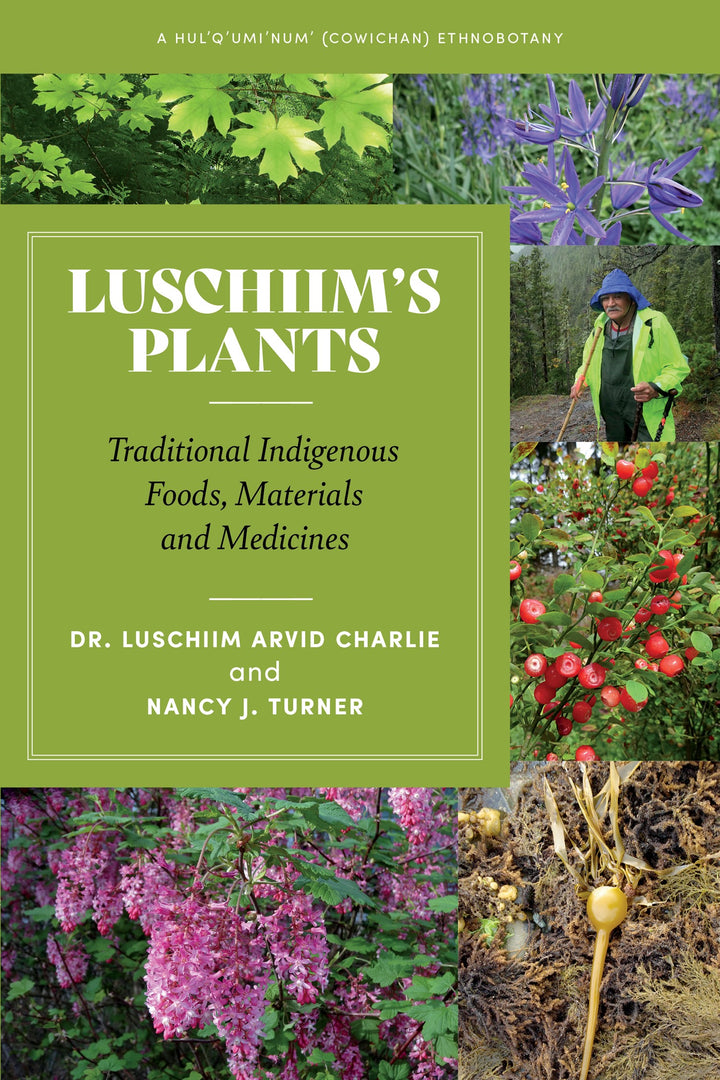
Luschiim’s Plants: Traditional Indigenous Foods, Materials and Medicines
Review By Agnieszka Pawlowska-Mainville
January 27, 2022
BC Studies no. 213 Spring 2022 | p. 166-167
This is a beautiful collaboration between Drs. Luschiim Arvid Charlie and Nancy Turner. The book is an album and encyclopedia which identifies the different plants located within the Quw’utsun territory. After a brief introduction to Hul’q’umi’num’ linguistic writing systems and methodology, the book delves into the details of plants in alphabetical order. Divided into nine categories — seaweeds, lichens, fungi and mushrooms, mosses, ferns, coniferous trees broad-leaved trees, shrubs and vines, as well as herbaceous flowering plants — the work examines almost two hundred species. Each plant is organized by its English name (as title) followed by the Latin name, plant family, and the Hul’q’umi’num’ name. Each physical description of the plant is then followed by the location where it can be found and a discussion of the cultural knowledge of the plant.
The book is a catalogue of the intricate knowledge Luschiim has of his ‘backyard’. For those passionate about language and cultural knowledge (Traditional Ecological Knowledge or TEK), the Hul’q’umi’num names of plants illustrate the descriptive nature of the language and its importance to land-based practices. An example I particularly enjoyed was of the trembling aspen (Populus tremuloides), which in Hul’q’umi’num literally means ‘little dancing tree’, qw’iiqw’i’yul’ushulhp. Luschiim notes that observation is increasingly being lost in our modern world, and observing aspen teaches us the way Indigenous people on the Island read the weather. In discussing the importance of observation for survival, Luschiim notes that “we’ve lost the ability to be observant. […] So you watched the weather, the clouds, the winds, the way the birds behaved, how the sound.” (pg. 108). The ‘dancing’ of the aspen tree leaves is an indicator of the weather, including echo: “Echo all comes into it. Echo, or lack of it” (pg. 108). And while I’m not too certain how the echo exists in the trembling tree, I will definitely be on the lookout this summer for the ‘sound’ the wind makes as the aspen dances.
The audience of the book may be limited to people on Vancouver Island, because the knowledge associated with the plants is very culture- and region-specific. Having said that, Hul’q’umi’num’ knowledge of one specific plant can aid in enhancing knowledge and use of the plant species in general. For example, the dwarf Wild Rose or Baldhip rose (Rosa gymnocarpa) is a common plant across British Columbia. The rose plant is generally known for making teas from the petals and rosehips, as these are a good source of vitamin C (p. 158-159). I also rely on the rose plant for teas and jams, and we often snack on the large hips called ‘głòg’ in Polish. However, I was not aware that the young offshoots can be eaten and that rose twigs can be a part of the tea as well. Luschiim writes that “the leaves, twigs, petals and hips can be used to make tea, and the outer rind of the hips is edible. You can also eat the the’thqi, or young shoots” (page 158). Likewise, the Anishinaabeg use the red-osier dogwood (Cornus stolonifera) for a number of practices, including spiritual uses. I have not come across any Anishinaabeg who used the red osier to draw out poison or bee stings in the way that Luschiim describes (on page 127).
The book is a beautiful gallery of stories about plants from the Quw’utsun world view. The work is useful for biologists, ethnobotanists, and those families working with plants for their own use. More importantly, the work is an immensely helpful tool for younger Cowichan people hoping to learn more about their Hul’q’umi’num’ language, plant knowledge, and cultural practices associated with plants sourced from their own territories. The book is very accessible to all audiences, especially given that the photographs aid in identifying the plants and communicating how the different plant uses changed with time. Lastly, the book is notable for not only focusing on ‘traditional’ plants, but also including all plants used in the area in Luschiim’s living memory. I was pleasantly surprised at the domesticated plum (Prunus domestica) being on the list of plants associated with Quw’utsun cultural knowledge, as it illustrates the wide array of species Indigenous people use to enrich their way of life.
Publication Information
Charlie, Luschiin Arvid and Nancy J. Turner. Luschiim’s Plants: Traditional Indigenous Foods, Materials and Medicines. Madeira Park, BC: Harbour Publishing Co. Ltd, 2021. pp. 274. $29.95 paper.
